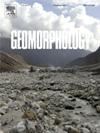Response to sea-level change in a non-deltaic coastal plain: Insights from cores chronologies
IF 3.1
2区 地球科学
Q2 GEOGRAPHY, PHYSICAL
引用次数: 0
Abstract
The North coastal South China Sea (SCS) contains densely populated deltaic and non-deltaic plains. While recent dating has advanced knowledge on land-sea interactions in deltaic areas, chronological data for non-deltaic plains remain lacking, hindering a full understanding of coastal evolution. This study establishes the first chronological framework since late-Pleistocene for Longjiang plain, a non-deltaic coastal plain shaped by wind, ocean and fluvial forces. Using quartz Optically Stimulated Luminescence (OSL) and radiocarbon (14C) dating on two cores, combined with Bayesian age-depth modeling, we identified depositional hiatuses between >123 ± 8 ka and ka and between >72 ± 4 ka and ~ ka, respectively. These hiatuses were attributed to intensive erosion during last glacial sea-level fall/low stands. Below the hiatuses are strongly weathered sediments. Post-hiatus aeolian deposition during ka– ka is linked to post-glacial sea-level rise. By contrast, aeolian deposition after ka successive to tidal deposition is likely triggered by local regression caused by increased sediment supply, favored by human activity since ~2.5 ka. Erosion during last glacial sea-level fall/low stands and aeolian deposition during the latest interglacial (Holocene) sea-level high stands, support the view that aeolian dunes preserved in modern coastal areas are mainly formed at sea-level high stands, rather than low stands. They also indicate that coastal erosion-accumulation cycles, controlled by eustatic sea-level fluctuation are not limited to deltas but may prevail in non-delta coasts. Quartz OSL sensitivity variations are observed in both cores and linked to provenance change, rework/redeposition by wind or Long-term chemical weathering.
求助全文
约1分钟内获得全文
求助全文
来源期刊

Geomorphology
地学-地球科学综合
CiteScore
8.00
自引率
10.30%
发文量
309
审稿时长
3.4 months
期刊介绍:
Our journal''s scope includes geomorphic themes of: tectonics and regional structure; glacial processes and landforms; fluvial sequences, Quaternary environmental change and dating; fluvial processes and landforms; mass movement, slopes and periglacial processes; hillslopes and soil erosion; weathering, karst and soils; aeolian processes and landforms, coastal dunes and arid environments; coastal and marine processes, estuaries and lakes; modelling, theoretical and quantitative geomorphology; DEM, GIS and remote sensing methods and applications; hazards, applied and planetary geomorphology; and volcanics.
 求助内容:
求助内容: 应助结果提醒方式:
应助结果提醒方式:


